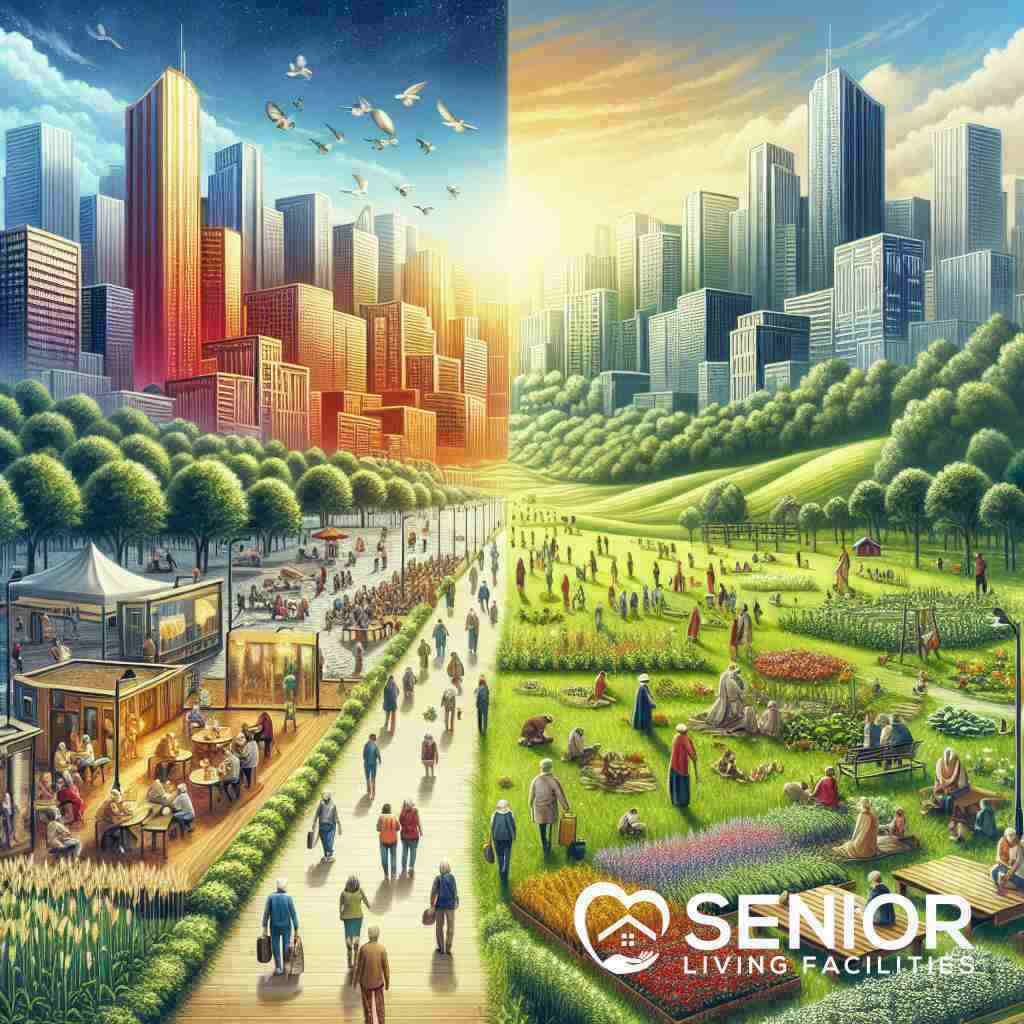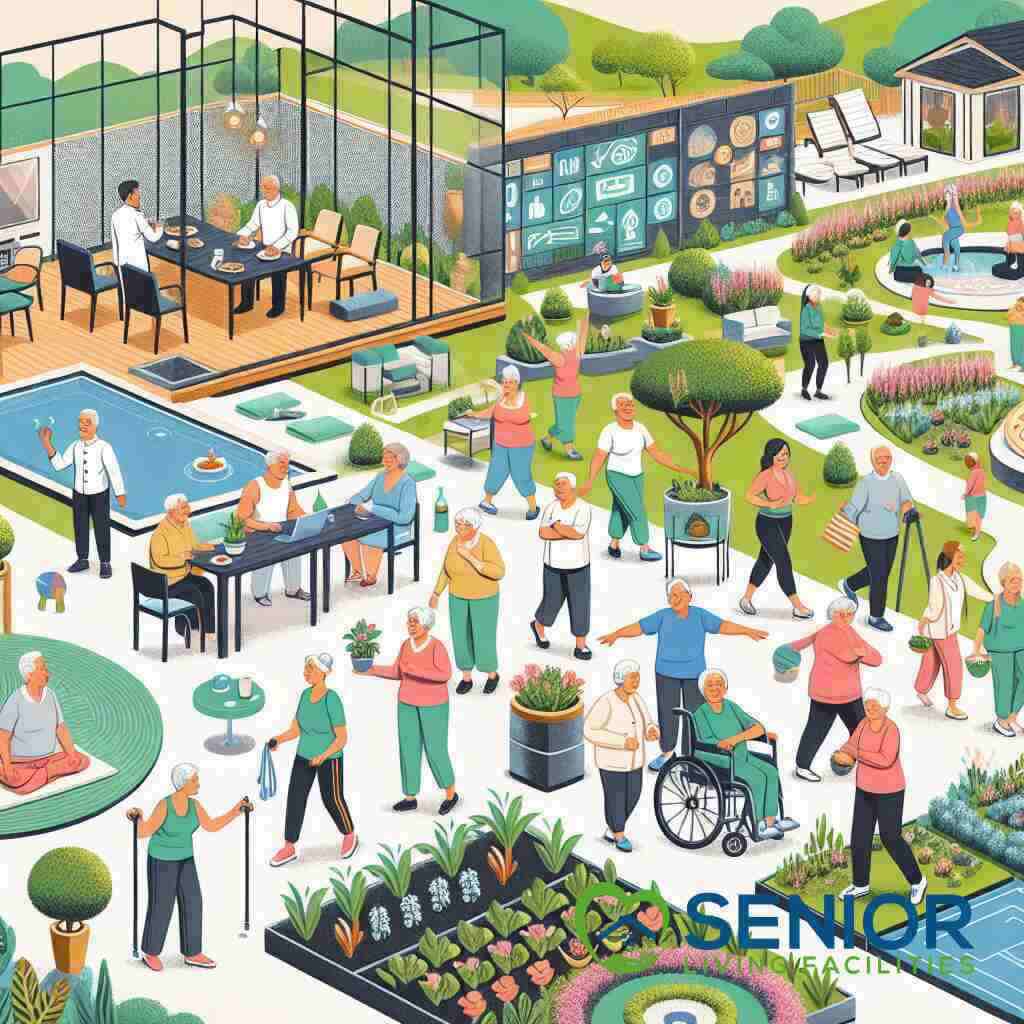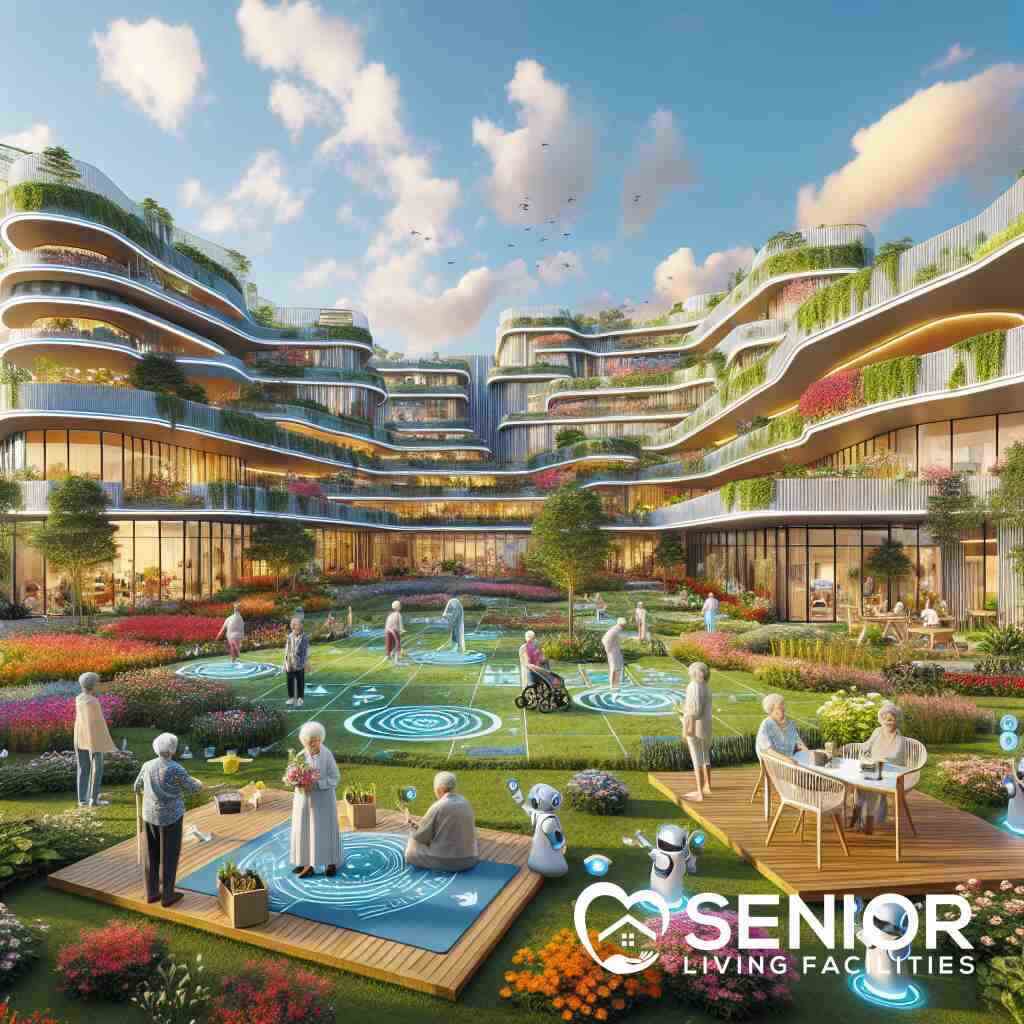
Comparing Urban and Rural Senior Living Dynamics
April 23, 2025
Introduction: The Crossroads of Senior Living
Exploring the Divergence: Urban vs. Rural Senior Living
The distinction between urban and rural senior living is fundamental, affecting every aspect of the experience for older adults. In cities, the landscape of senior living is bustling with a variety of vibrant options, whereas the rural scene offers a more serene environment. Each setting brings its own set of challenges and benefits, such as differing levels of healthcare access and amenities typical in urban retirement community characteristics. When comparing urban versus rural senior living environments, it becomes evident how one’s location significantly impacts their lifestyle, access to care, and overall well-being. Understanding these divergences helps older adults and their families make informed choices about where to nest as they age.
The Impact of Location on Senior Care Options
Location plays a critical role in shaping senior care options, influencing everything from available facilities to the type of lifestyle one can lead. Urban settings often boast an array of senior living facilities, offering diverse healthcare services, cultural attractions, and social connectivity. In contrast, rural areas might provide fewer choices but compensate with more intimate, close-knit communities and a slower pace of life. For senior care options in New York
, you might find access to state-of-the-art facilities and a robust network of medical professionals, something less prevalent in their rural counterparts. Evaluating these factors helps tailor the right senior living plans, merging personal preferences with tangibles like health care and social interaction.
Understanding the Needs: Urban vs. Rural Lifestyle Preferences
The needs and preferences of seniors residing in urban or rural environments can differ vastly. City dwellers often prioritize access to public transportation, cultural activities, and diverse social networking opportunities. Meanwhile, the allure of rural living typically revolves around space, nature, and a slower, more peaceful pace. Understanding the senior lifestyle in cities reveals that many appreciate the vibrant opportunities that urban environments provide, from bustling marketplaces to engaging cultural activities in urban senior communities. Conversely, rural seniors may seek the peace and tranquility that comes from being closer to nature, which is an important consideration for those prioritizing serenity in their golden years. Grasping these differing lifestyle preferences is crucial in choosing a senior living setting that honors and enriches the individual’s later-life choices.
A Cityscape of Senior Living: Urban Dynamics Explored
Navigating Urban Senior Housing: Choices and Challenges
Urban senior housing provides a plethora of options that offer varied experiences to suit individual desires. Cities present unique senior living facilities, from high-rise apartments with panoramic views to quaint neighborhood enclaves. However, navigating these choices involves understanding both benefits and challenges. The dense urban framework facilitates easy access to a host of services but often comes at the expense of higher costs and limited space. Furthermore, urban environments can pose challenges like noise and traffic, which can significantly impact the quality of senior living. For seniors considering these housing options, thinking about how to balance the attractions of urban living with personal comfort is crucial.
Despite challenges, cities offer unparalleled opportunities for seniors to connect through exploring rental housing for seniors, providing diverse housing arrangements adaptable to various needs.
Healthcare Metropolis: Access and Availability in Urban Settings
Healthcare access is a pivotal concern for seniors, and urban areas generally excel due to their concentration of advanced medical facilities. Cities boast top-tier hospitals, specialty clinics, and a broad spectrum of healthcare professionals readily available for seniors. The density of quality medical care in urban environments enables prompt healthcare interventions and comprehensive wellness programs, thus enhancing overall well-being. However, the abundance of choices may sometimes feel overwhelming for seniors navigating senior care options.
In addition to sheer availability, urban areas often provide specialized services geared towards elderly care, including mobile healthcare options and telemedicine. This infrastructure significantly contributes to better access to healthcare for seniors, underpinning its critical role in urban senior living dynamics.
Cultural Cornucopia: The Role of Urban Amenities in Enriching Senior Life
Cultural amenities serve as the backbone of urban senior living, offering a rich tapestry of activities that engage and stimulate. Metropolitan areas deliver a cultural cornucopia, from art galleries and theaters to music concerts and museums, providing ample opportunities for recreation and cultural enrichment. For seniors, engagement in such activities fosters mental agility, social interaction, and a vibrant lifestyle. That cultural vibrancy can transform the senior living experience, bridging intergenerational gaps and enhancing individual fulfillment.
Moreover, urban environments often sponsor senior-specific programs within these venues, encouraging active participation and communal bonding. These amenities carve a distinct niche for urban retirement communities, making city living an enticing option for those seeking a culturally enriched lifestyle.
Urban Senior Lifestyle: Opportunities for Social Connections
City life naturally presents various avenues for establishing and maintaining social connections among seniors, which is crucial for emotional and psychological health. Seniors in urban environments have an array of platforms to engage, from local community centers and clubs to volunteer groups and special interest meetups. The potential for diverse social interactions in urban settings fosters a dynamic lifestyle where seniors can form meaningful relationships and cultivate a sense of belonging.
In metropolitan settings, community connections in senior living frequently hinge upon the proximity of diverse social activities within the urban fabric. These interactions not only combat loneliness but also enhance the overall quality of life, making cityscape living a vibrant and socially fulfilling choice for seniors looking to maintain active engagement through social communities.
Pastoral Tranquility: The Essence of Rural Senior Living
Rural Housing Paradigms: Simplicity and Space
In the rural landscape, senior housing paradigms prioritize simplicity and space, offering a lifestyle appealing to those who prefer broader horizons and less congestion. Unlike urban senior housing, the rural environment provides larger living areas often surrounded by open land, allowing seniors to enjoy a sense of spaciousness and freedom. These rural senior communities in the Midwest often feature homes with ample gardens and outdoor spaces, nurturing a connection with nature. The simplicity of these settings allows seniors to focus on personal wellness and hobbies without the distractions typical of urban living. Exploring Unique Senior Facilities in Florida. Together, these elements craft a tranquil and fulfilling environment, perfect for individuals seeking a serene lifestyle.
Healthcare Horizons: Navigating Access in Rural Areas
Access to healthcare in rural settings presents both opportunities and challenges for seniors. While some rural areas may lack the diversity of healthcare providers found in cities, they often compensate with personalized, community-driven care strategies. The smaller population in rural areas allows for more thorough, individualized attention from healthcare professionals familiar with each patient’s history. Enhancements like telehealth services are closing gaps, increasing the reach of medical care, and boosting health outcomes for rural seniors. Despite this, the logistical nuances of accessibility can be demanding, requiring strategic planning and reliable transportation networks. Initiatives aimed at improving transportation in senior housing continue to bridge the healthcare access divide between urban and rural areas.
Embracing Nature: The Peace and Tranquility of Rural Living
Nature’s embrace is a defining feature of rural senior living, offering serenity and a reprieve from the frenetic pace often found in urban locales. Seniors who choose rural retirement communities often revel in the natural settings in rural senior living, surrounded by trees, fields, and wildlife. These settings provide opportunities for outdoor activities such as gardening, walking, or simply enjoying the landscape, as a therapeutic advantage that enhances mental and physical well-being. The connection to nature in rural senior living environments nurtures a tranquil lifestyle, helping residents achieve a sense of peace and contentment.
Rural Communities: Fostering Close-Knit Social Bonds
The social fabric of rural senior living is woven through close-knit community bonds that offer a profound sense of belonging. Smaller populations and familiar landscapes encourage deeper social interactions, with neighbors often knowing each other personally. Regular community events, from farmers’ markets to local festivals, facilitate interactions among seniors, fostering friendships and support networks. In these communities, there is a distinct opportunity to engage meaningfully with others, reinforcing the warmth and camaraderie typical of rural life. Such connections are fundamental to enhancing the quality of senior living in rural settings, where social bonds play a pivotal role in promoting mental health and emotional resilience.
Comparative Analysis: The Urban-Rural Senior Living Dichotomy
Cost Considerations: A Financial Comparison
Understanding the financial aspects of senior living is crucial for choosing between urban and rural settings. Urban areas generally present higher living costs due to property values, services, and taxes. Seniors opting for city life might encounter steeper housing prices and elevated fees for amenities. On the other hand, rural living often comes with reduced expenses, thanks to lower real estate prices and minimal congestion-related costs. However, any potential cost savings in rural areas could be offset by additional expenses for travel and specialized services unavailable locally. Examining the financial aspects of senior living provides a comprehensive vision of the economic implications connected with each environment.
Transportation and Accessibility: Urban vs. Rural Senior Facilities
Transportation and accessibility are pivotal when comparing urban versus rural senior living accommodations. In cities, robust public transportation systems, such as buses and subways, offer seniors reliability and ease of movement. Urban areas also facilitate access to senior homes and health facilities due to shorter travel distances. Conversely, rural areas may lack public transport options, leading to dependency on personal vehicles or community services. This limitation necessitates planning for alternative transportation solutions. Despite the challenges, some rural senior housing effectively integrates transportation to ensure comprehensive accessibility. Accordingly, evaluating these elements is essential for tailoring individual senior living plans in rural and urban settings.
Quality of Life Metrics: Evaluating Senior Satisfaction
Assessing senior satisfaction involves examining various quality of life metrics across urban and rural landscapes. While urban environments provide extensive healthcare, social opportunities, and cultural engagements, they can also introduce challenges with noise and pollution. Senior Living Facilities: Impact on Community Health 2025 Rural areas offer peace and tranquility, with the natural surroundings fostering mental well-being, though they may lack certain amenities typical in cities. Understanding the complex dynamics of urban versus rural senior living helps gauge how these settings impact senior satisfaction, enabling more informed lifestyle choices.
Tailoring Senior Living Plans: Personalized Choices in Urban and Rural Settings
Crafting personalized choices for senior living requires a nuanced understanding of urban and rural dynamics. Urban settings cater to seniors seeking active engagement, widespread healthcare, and diverse lifestyle options such as vibrant social interactions and cultural amenities. Meanwhile, the rural environment offers tranquility and space, suited for those prioritizing serenity and closer community bonds. Tailoring senior living plans involves balancing these factors in alignment with the individual preferences of seniors or their families, ensuring that housing options for seniors reflect their unique needs and aspirations. By comparing urban senior living dynamics with rural alternatives, families can make more informed decisions.
Conclusion: Harmonizing the Senior Living Experience
Bridging Two Worlds: Integrating Urban and Rural Senior Living Benefits
Integrating the distinct advantages of urban and rural senior living can create an enriched, balanced senior living experience. Urban environments provide a plethora of cultural and social opportunities, connecting seniors through vibrant activities and access to comprehensive healthcare. On the other hand, the rural setting offers peace, tranquility, and a deeper connection to nature, which are conducive to mental well-being and relaxation. By understanding the unique offerings of each environment, seniors can create a living arrangement that encapsulates the best of both worlds, ensuring a harmonious blend of activity and serenity. Careful planning allows the integration of urban amenities, like robust healthcare and cultural activities, with the tranquility of rural vistas, resulting in a dynamic senior living environment tailored to individual needs. Employing technology and community resources further supports this harmony, enhancing accessibility and connectivity for seniors. For example, resources like our comprehensive guide on senior living highlight adaptable living options that blend urban and rural benefits, ensuring that seniors are equipped with varied choices.
Final Thoughts on Choice and Quality of Life for Seniors
Choosing between urban and rural senior living is not merely a decision about location but about quality of life, individual preferences, and long-term well-being. Both environments offer distinct experiences, and the right choice hinges upon personal priorities, be it cultural engagement, healthcare accessibility, or a peaceful community setting. By carefully evaluating the array of senior living accommodations in different areas, such as the varied senior living accommodations in Arizona, seniors and their families can make informed decisions.
Ultimately, the goal is to ensure that seniors lead fulfilling, engaged, and contented lives in environments that support their unique lifestyles and health needs. Encouraging a dialogue that considers both urban vitality and rural serenity enriches the options available, underscoring the importance of choice in enhancing the quality of life for seniors across diverse landscapes. With informed decisions and tailored plans, seniors can find satisfaction and joy in their chosen communities, embodying the commitment of Senior Living Facilities to foster a supportive and nurturing environment for all.
Frequently Asked Questions
Question: How does the location impact the quality of life for seniors in urban versus rural settings?
Answer: Senior Living Facilities believes that location is a critical determinant in seniors’ quality of life when comparing urban and rural senior living dynamics. Urban environments offer extensive healthcare access and social opportunities, creating a vibrant lifestyle that fosters active engagement. Conversely, rural living provides peace and tranquility, with vast natural surroundings beneficial for mental well-being. Our platform helps families compare these environments, allowing them to weigh the benefits of urban senior living dynamics against the calm rural settings to make informed choices that enhance life satisfaction.
Question: What are the key differences in healthcare access for seniors residing in urban versus rural communities?
Answer: Through our extensive database, Senior Living Facilities showcases significant differences in healthcare access between urban and rural settings. Urban areas generally boast a higher concentration of healthcare facilities, including hospitals and specialty clinics, making advanced and diverse medical services readily available. In contrast, rural communities may offer fewer healthcare options but often provide personalized care through a smaller, more familiar medical team. Understanding these differences helps seniors and families choose the best urban or rural retirement communities suited to their healthcare needs, ensuring they receive the highest quality of medical care available.
Question: How do transportation and accessibility vary between senior living options in cities compared to rural areas?
Answer: Urban senior living dynamics typically include robust public transportation systems, offering seniors ease of movement with buses and subways nearby. This infrastructure supports convenient access to amenities and healthcare facilities. Conversely, rural senior housing may lack such options, relying more on personal vehicles, which can affect accessibility. At Senior Living Facilities, we assist in highlighting these divergences, aiding seniors in making informed decisions on housing options that match their transportation needs, whether it’s urban convenience or rural simplicity. Exploring Eco-Living Innovations at Senior Living Facilities
Question: What should seniors consider when choosing between urban and rural senior living settings in terms of social connectivity?
Answer: Social connectivity is integral to senior living, influencing emotional and mental health. Urban areas offer vibrant activity opportunities, with community centers and cultural events providing platforms for seniors to form meaningful relationships. Meanwhile, rural settings emphasize close-knit communities where deeper bonds are formed with fewer people. Senior Living Facilities helps seniors assess these social dynamics by providing comprehensive information about senior living community comparisons, ensuring that they select environments best suited to their social engagement needs.
Question: In the blog “Comparing Urban and Rural Senior Living Dynamics,” how do Senior Living Facilities address cost considerations for these different settings?
Answer: The blog highlights that urban living typically involves higher costs due to elevated property values and services, while rural living can offer reduced expenses through lower real estate prices. However, rural cost savings can be offset by travel expenses and access to specialized services. Senior Living Facilities offers tools to compare these financial aspects, helping families understand the full economic impact of each environment. How Senior Living Facilities Transform Lifestyle Choices. By aligning budgetary constraints with desired senior living features, we support informed decision-making, ensuring cost-effective and satisfying senior living arrangements.




